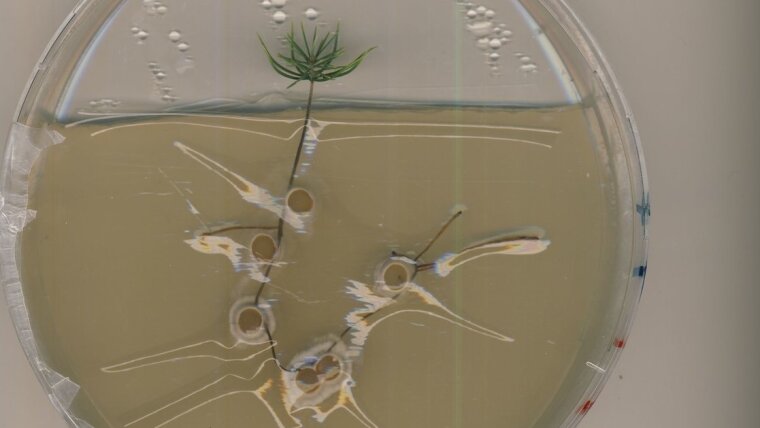
Tricholoma vaccinum and spruce (Picea abies).
Image: Katrin Krause (Cover-Bild: Journal of Basic Microbiology, 2/2016)Colonization strategies and host specificity of ectomycorrhizal fungi are examined. Fungi of the genus Tricholoma are capable to form a host-specific, mutually symbiotic relationship with trees. The sequenced genome of Tricholoma vaccinum and an Agrobacterium tumefaciens mediated transformation system enable functional analyses. An aldehyde dehydrogenase and a MATE transporter are induced during the establishment of the symbiosis and the symbiotic tissues. Also, hydrophobins – small, secreted proteins with involvement in formation of aerial hyphae and mycorrhiza development – were examined in the specific symbiosis of T. vaccinum with spruce (Picea abies) with inclusion of the signal exchange with other soil microorganisms and the host, whereby sesquiterpenes play a role. T. vaccinum influences the phytohormone balance of the host tree through these terpenes. Isotope labeling was used to elucidate the geosmin biosynthesis.
The mycorrhizosphere microbiome exerts a considerable influence on the communication with the host plant. Simultaneously, the microbial community showed effects on the growth and hyphal branching behavior of T. vaccinum. Furthermore, plant root exudates and phytohormones were shown to control and direct the growth of the mycorrhizal fungus.
The influence of mycorrhiza on the forest ecosystem is also investigated in heavy metal contaminated habitats analyzing the biodiversity of the ectomycorrhiza and the occurrence of different exploration types in relationship with the environmental pollution. Axenic co-culture experiments are performed to elucidate molecular biological background of heavy metal responses. The production of edible mushrooms has been successful for saprotrophic species. In contrast, the investigation of high-priced ectomycorrhizal fungi such as truffles is difficult. In a field trial, the impact of the ectomycorrhizosphere’s microbiome is addressed.
Colleagues in these projects:
Dr. Katrin Krause, Levke Petersen.
Alumni: Dr. Manuela Östreicher, Dr. Oluwatosin Abdulsalam, Dr. Theodore Asiimwe, Dr. Maria Bizo, Dr. Olga Bogdanova, Dr. Marycolette Ezediokpu, Dr. Steffi Formann, Dr. Felicia Gherghel, Dr. Matthias Gube, Dr. Catarina Henke, Dr. Ines Schlunk, Dr. Dominik Sammer, Dr. Katharina Wagner, Dipl.-Biol. Cynthia Rüger, Dipl.-Biol. Christine Steinbach.
Most important publications:
Ezediokpu MN, Halitschke R, Krause K, Boland W, Kothe E (2023) Pre-symbiotic response of the compatible host spruce and low-compatibility host pine to the ectomycorrhizal fungus Tricholoma vaccinum. Original Research, Front. Microbiol. - Microbial Symbioses. Manuscript ID: 1280485.
Bogdanova O, Kothe E, Krause K (2023) Ectomycorrhizal Community Shifts at a Former Uranium Mining. J. Fungi, 9 (4):483.
Ezediokpu, MN, Krause K, Kunert M, Hoffmeister D, Boland W, Kothe E (2022) Ectomycorrhizal Influence on the Dynamics of Sesquiterpene Release by Tricholoma vaccinum. J. Fungi 8, 555. https://doi.org/10.3390/jof8060555
Abdulsalam OA, Krause K, Überschaar N, Kothe E. (2022) Geosmin synthase ges1 knock-down by siRNA in the dikaryotic fungus Tricholoma vaccinum. Journal of Basic Microbiology. 62(2):109-115. https://doi.org/10.1002/jobm.202100564
Abdulsalam O, Wagner K, Wirth S, Kunert M, David A, Kallenbach M, Boland W, Kothe E, Krause K (2020) Phytohormones and volatile organic compounds, like geosmin, in the ectomycorrhiza of Tricholoma vaccinum and Norway spruce (Picea abies). Mycorrhiza, doi: 10.1007/s00572-020-01005-2.
Wagner K, Krause K, Gallegos-Monterrosa R, Sammer D, Kovács ÁT, Kothe E (2019) The ectomycorrhizospheric habitat of Norway spruce and Tricholoma vaccinum: promotion of plant growth and fitness by a rich microorganismic community, Front Microbiol 10, 307. doi: 10.3389/fmicb.2019.00307.
Bizo ML, Nietzsche S, Mansfeld U, Langenhorst F, Goettlicher J, Majzlan J, Ozunu A, Formann S, Krause K, Kothe E (2017). Response to lead pollution: mycorrhizal Pinus sylvestris forms the biomineral pyromorphite in roots and needles. Environ Sci Pollut Res Int 24(16),14455-14462. doi: 10.1007/s11356-017-9020-7. Epub 2017 Apr 25.
Sammer D, Krause K, Gube M, Wagner K, Kothe E (2016). Hydrophobins in the life cycle of the ectomycorrhizal basidiomycete Tricholoma vaccinum. PLoS ONE 11(12), e0167773. doi:10.1371/journal.pone.0167773.
Henke C, Jung EM, Voit A, Kothe E, Krause K (2015). Dehydrogenase genes in the ectomycorrhizal fungus Tricholoma vaccinum: A role for Ald1 in mycorrhizal symbiosis. J Basic Microbiol Epub ahead of print. DOI: 10.1002/jobm.201500381.
Krause K, Henke C, Asiimwe T, Ulbricht A, Klemmer S, Schachtschabel D, Boland W, Kothe E (2015). Biosynthesis and secretion of indole-3-acetic acid and its morphological effects on Tricholoma vaccinum-spruce ectomycorrhiza. Appl Environ Microbiol 81, 7003-7011.
Schlunk I, Krause K, Wirth S, Kothe E (2015). A transporter for abiotic stress and plant metabolite resistance in the ectomycorrhizal fungus Tricholoma vaccinum. Env Sci Poll Res 22, 19384-19393.
Wagner K, Krause K, David A, Kai M, Jung EM, Sammer D, Kniemeyer O, Boland W, Kothe E (2015). Influence of zygomycete-derived D'orenone on IAA signaling in Tricholoma-spruce ectomycorrhiza. Environ Microbiol. Epub ahead of print. doi: 10.1111/1462-2920.13160.
Wagner K, Linde J, Krause K, Gube M, Köstler T, Sammer D, Kniemeyer O, Kothe E (2015). Tricholoma vaccinum host communication during ectomycorrhiza formation. Env Microbiol Ecol 91, Epub ahead of print DOI: 10.1093/femsec/fiv120.
